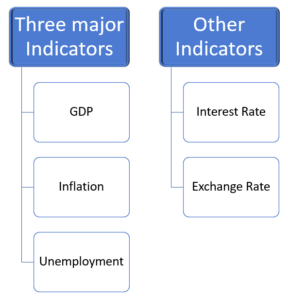The indicators of economic performance give us a way to assess how an economy is performing. They are explored in turn below.

1. Gross Domestic Product - GDP
Nominal GDP | Unadjusted for price |
Real GDP | Adjusted for inflation |
Ways of calculating GDP: | |
GDP(P): | Production/value added at each step – Revenue less cost |
GDP(E): | Expenditure by Households, Firms, Governments and Foreign Sector |
GDP(I) | Income |
Other measures | |
GDP | Based on nation – includes foreigners, excludes residents overseas |
GNP | Based on people – includes residents overseas, excludes foreigners |
GNI | Based on payment flows – includes money spent in the country/repatriated |
2. Inflation
Inflation is the rate of change of the price of goods.
It is measured as change in CPI.
CPI = cost of goods in current year / cost of goods in base year
Inflation results from price levels rising disproportionately to quantity. See the long-run average supply in the long-run business cycle section below.
3. Unemployment


Types of unemployment
Frictional | People trying to find new jobs |
Structural | Skills mismatch |
Cyclical | Following the economy |
Wages and employment are determined by the supply and demand for labour in a given industry.
An industry with high supply and low demand will have lower wages.
4. Interest Rates

Real Interest Rate | Reflects the real, economic cost of borrowing and return to lenders |
Nominal Interest Rate (advertised rate) | Incorporates compensation for expected erosion of value due to inflation. |
Central Bank Regulation of Interest Rates:
Central Bank tries to keep the real interest rate (r) constant by controlling the nominal interest rate (i) in response to inflation (π)
- If (π) increases, central bank increases (i) so as to not erode (r)
- If (π) decreases, central bank reduces (i) so that (r) doesn’t increase (this would increase saving)
5. Exchange Rates


Calculating the Exchange Rate
- The nominal exchange rate is the price of foreign currency over the base currency.
- The base currency is taken to be 1, so the exchange rate tells you how many units of the foreign currency can be bought by one unit of domestic currency.
- Appreciation is where one unit of base currency buys more of foreign currency. E.g. USD/AUD going from 0.7 to 0.8 means the AUD is getting stronger.
Currency markets are subject to demand and supply forces and influenced by:
- Interest rates (higher creates more demand)
- Favourabilty of investment opportunities
- Speculation (if investors expect a currency to depreciate, they will sell it) and it’s value will reduce
Types of Indicators
Leading | Observed before economic activity, often reflects expectations (e.g. optimism) | Consumer confidence, housing approvals |
Coincident | Observed at same time | GDP/ income |
Lagging | Observed after economic activity, often firms take time to respond | Unemployment |
